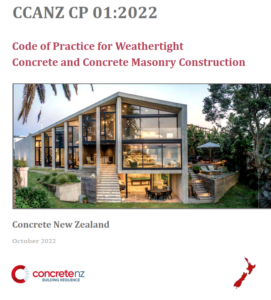
Concrete New Zealand has published a new document, CP01:2022 – Code of Practice for Weathertightness. It’s available to download from the Technical Documents section.
Note that this 2022 update is an Alternative Solution (still!) while the details in the 2014 version are Acceptable Solutions according to the New Zealand Building Code.
We’re ever so excited to see this published as the Sustainable Engineering team did the thermal analysis work contained in the Thermal Performance appendix (pp 137-195). It was great to work cooperatively with ConcreteNZ to review common details for New Zealand and potentially improved details. Although this document focuses on external moisture, thermal performance needs to be considered as we work to improve the standard of building in this country.
It’s wonderful to see fRSI used as a metric to evaluate the thermal performance of constructions—one day I expect this to be introduced into the Building Code. You can find more explanation on fRSI here.
Here’s what I had to say in the document’s foreword:
This new edition of the Code of Practice for Weathertight Concrete and Concrete Masonry Construction demonstrates admirable leadership from Concrete NZ, establishing new standard practices in advance of New Zealand Building Code minima. This positions the industry extremely well given MBIE has announced that the Building Code’s thermal performance requirements will continue to increase to help meet climate change targets.
Sustainable Engineering Ltd provided input into the previous edition of this manual, and my team was very pleased to again offer our expertise. One new focus in CCANZ CP01 is on thermal performance, and we calculated the thermal bridging and surface temperature factors (mould index) for the various details.
These calculations help architects and designers to understand the risk of mould growth and underpin comprehensive changes to the detailed drawings of this document. The temperature plots clearly show the performance gains that can be made by using these updated details, but it’s also useful to think about the qualitative benefits:
- Concrete that is better insulated and transfers less energy via thermal bridges saves on heating and cooling bills for the life of the building.
- Comfortable temperatures in buildings are easier to maintain, and that’s good for the wellbeing of the people that occupy them.
- Comfortable temperatures are also good for the environment, as heating and cooling buildings account for a significant proportion of New Zealand energy use and resultant greenhouse gas emissions.
- Finally, there is a financial benefit for the owner, occupier or lessee—whoever is paying utility bills.
Preventing cold spots caused by thermal bridging also means reducing or removing the risk of mould. This means better building durability and it’s also very important for the health of those who live and work and learn in these buildings. Mould is a significant health hazard, especially for people with respiratory illnesses (and sadly, New Zealand is a world leader in rates of asthma and other lung conditions).
When we build better, everybody benefits.